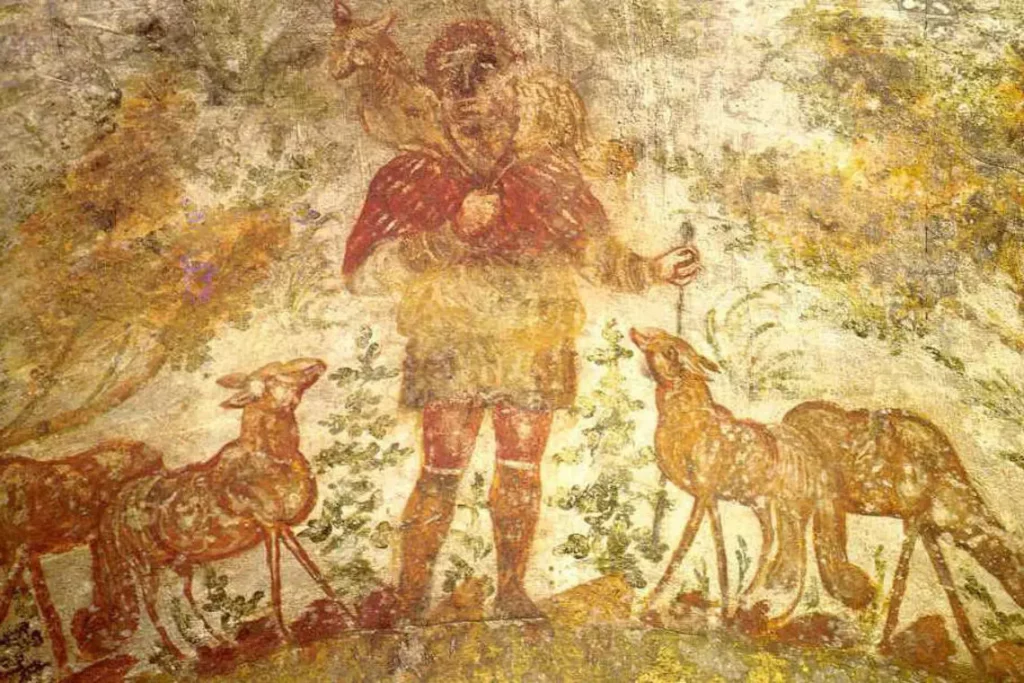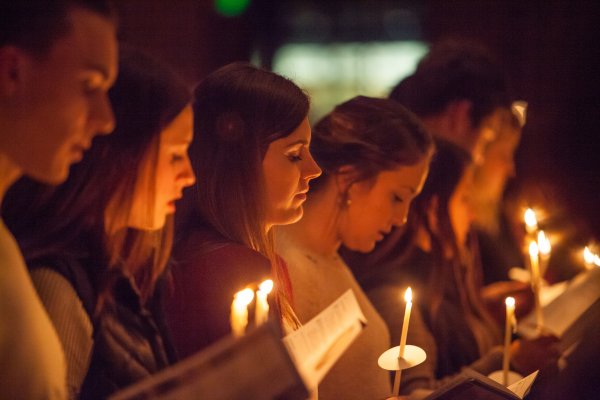Where is the good shepherd carrying you?

Among the earliest known images that can be identified as representing Jesus are those that depict him as a man carrying a lamb over his shoulders – the Good Shepherd. In this image from the Catacombs of Domitilla, typically dated to the late third century, in addition to the lamb, Jesus the Good Shepherd is accompanied by four other sheep, two gazing at Jesus and two calmly grazing as though they had nothing to fear. Out of the frame but in the same image plane, wild animals prowl. The danger is real yet the sheep are unconcerned.
This image has biblical precedent. Jesus identifies himself as the Good Shepherd as recorded in the tenth chapter of the Gospel according to John. The design of this image, however, comes from another source. In Greece, images as well as sculptures of a man carrying a lamb, sometimes over his shoulders, sometimes cradled in his arms, date back as far as the seventh century BCE and are associated with the cult of the Ram Bearer which was thought to prevent disease brought by “bad air” in the cities where it was practiced. More broadly, the image was also used to evoke the pleasures of the country life where one might live in peace and abundance.
When Christians take over this image and have it painted on the walls and ceilings of their tombs, the centuries-old design gets a profound reinterpretation. No longer is the viewer called to identify with the human figure as the archetype of the one invoking the favor of the gods or the handsome man living the good and peaceful life. Now the human figure is Jesus, the Good Shepherd who accompanies the sheep in the midst of danger. The viewer is invited to see themselves as the lamb being carried. The question is, “Where is Jesus carrying his lamb?”
“The shepherd is carrying the lamb out of danger!” we might reply. Certainly that’s the implication of Psalm 23, the one about how the Lord is my shepherd. The shepherd leads me to green pastures and still waters and a dwelling place in his house. But the shepherd also accompanies the lamb through the “valley of the shadow of death” and into the presence of enemies. Moreover, as we apply these ideas to our own lives, we’ll all need to agree that our affiliation with Jesus doesn’t serve to keep us out of trouble. Trouble in this world, whether it’s disease or some other distress, has a way of finding us anyway. Sometimes, we even find it ourselves through our own acts of foolish sinfulness. The valley of the shadow of death is familiar territory. Maybe the shepherd isn’t so good after all.
As he describes all of the ways that he is the Good Shepherd, Jesus identifies his own encounter with death to be the highest expression of his shepherdly goodness. He lays down his life for his sheep. This isn’t just an expression of self-destructive sacrifice. He claims to have the power to lay down his life and the power to take his life back up again. The valley that Jesus walks through isn’t just the shadow of death, but the brutal reality of death. He walks right through and out the other side.
It strikes me that by painting the image of the Good Shepherd inside the tombs of their beloved ones, our forebears in the faith by taking the older image of the man with the lamb over his shoulders were saying, “The Good Shepherd will carry our loved one through this death. As we lay our loved one down in death, Jesus will take her up again into life.”
Jesus the Good Shepherd doesn’t get us out of trouble. He goes with us through our trouble.
Pr Jim
April 28, 2021
Rev. James A. Wetzstein serves as University Pastor at Valparaiso University and takes turns writing weekly devotions.
- Archives of Devotional Writings from our Pastoral Staff
- “HELP!”
- “Some Lent!”
- (Your vocation here) of people
- A call to courage for 2021
- A charming tale for over-achievers
- A Lesson On Beans … and Being
- A New Place
- A Point of Privilege
- A season of anticipation
- A Time of Dust
- Acquiring a peaceful spirit
- Advent = Hope
- All will be well
- Anastasis: the Greatest Story of God’s Saving Power
- Another kind of darkness
- Are we willing to cross the road for one another?
- As if we needed a reminder
- Beacons of hope
- Better Together
- Blessings As You Go
- Borderlands
- Can we learn to be happy?
- Carrying the COVID Cross
- Come and See
- Did Jesus really suffer?
- Doing without in a life of plenty
- Don’t miss this moment
- Exiles with Vision
- Fear not!
- Fear of the Lord
- Feeling at Home
- Finding Purpose in the Journey
- Finding Words for Times Like These
- Forgiving others – and ourselves
- Getting ahead with Jesus
- Getting down on Jesus’ level
- Getting through this together
- God is not overwhelmed
- Good Friday
- Grief & Graduation
- Have yourself a merry little Christmas — somehow
- Holy Week and Taking Out the Trash
- Holy Week: The aid station late in the semester
- Hopes & Dreams vs Life in the Wilderness
- How do you keep from giving up hope?
- How glad we’ll be if it’s so
- I almost slipped
- Imagining Eternity
- In a time of uncertainty, these things are certain
- In everything, grateful
- In praise of plans B … C … D …
- In the midst of grief, God will bring life
- Is there such a thing as being too forgiving?
- It’s a Three Day Weekend!
- It’s In the Bag
- It’s What’s Happening
- Jesus among us
- Killing off our future selves
- Knowing a Good Thing When We See It
- Lessons in fire building
- Let there be light!
- Let us work for real wellness in our communities
- Life Is a Highway
- Lilies and leaves and whatever else is beautiful
- Living in the Present
- Naming our demons
- O Lord, you know I hate buttermilk
- Of Fear and Failure
- On Christian Unity: When we’re not one big happy church
- On the Bucket List
- On the day after the night before
- Overwhelmed
- Persistent and Extravagant
- Pray and Let God Worry
- Praying for Reconciliation
- Preparing for the world to be turned rightside up
- Recovering from an Epic Fail
- Reformation calls for examination
- Remembering among the forgetful
- Rest
- Rest is Holy
- Right where we are
- Seeing beauty in brokenness
- Signs of Love
- Starting Small
- Still in the storm
- Surprisingly Simple: Breathe!
- Taking a Break from the Relentless
- Talking ourselves into it
- Thankfulness leads to joyfulness
- The Art of Holy Week
- The Funny Business of Forgiveness
- The Greatest of These is Love
- The Magi: Exemplars of Faith and Learning
- The Power of Small Conversations
- The Trouble with Mammon
- The Power of Taking a Sabbath
- The Spiritual Gift of Hindsight
- This can’t be done alone
- To be known
- Too.Much.
- You might be a Lutheran if…
- You will be in our prayers this summer of 2020
- Ventures of which we cannot see the ending
- WWJD? We already know
- Walking in the Light of Jesus’ Resurrection
- We had hoped
- We’re on a mission from God
- What do you do with your anger?
- What good is a shepherd?
- What is your base reality?
- What to do after you find your voice
- What to do on the day after
- What we know and what we don’t know
- When bad things happen
- When God uses something terrible for good
- When heaven & earth click
- When joy and sadness live together
- When stress overwhelms
- When the promise of resurrection is hard to believe
- When you offer up your broken cup
- When we are moved
- Where God will be found
- Where is the good shepherd carrying you?
- Wilderness Journeys
- Won’t you be my neighbor?
- Year-end time management: Keeping the main thing the main thing
- Your Valpo roots will help you grow into your future
